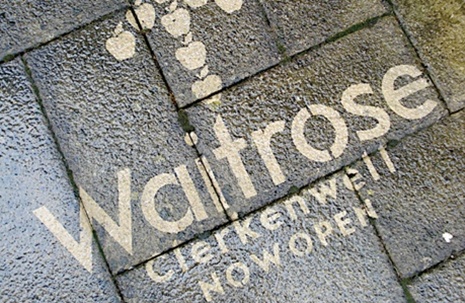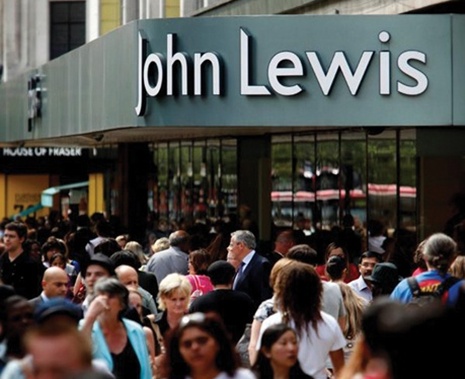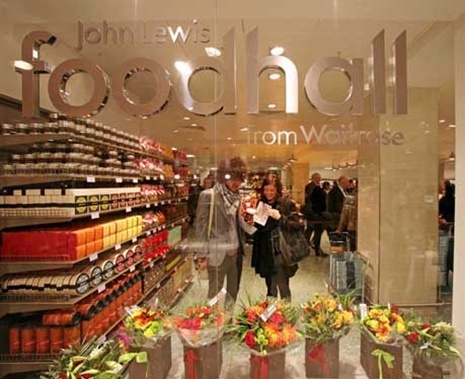Profile: Sir Charlie Mayfield, chairman of the John Lewis Partnership
On its 150th anniversary, the retailer talks about the 5% of customers that make up 50% of profits and the future of the partnership.
“Customers are changing the way they live their lives in a fundamental way and technology is the primary driver of that. Retailers like us have to be extremely agile and adaptable in terms of changing our operating model,” says John Lewis Partnership chairman and former marketer Sir Charlie Mayfield, speaking exclusively to Marketing Week before giving the Marketing Society’s Annual Lecture last month (see Mayfield on marketing, below).
While the John Lewis and Waitrose brands, which are part of the partnership, must adapt, Mayfield’s job is made harder by the fact that its high-value customers are constantly changing.
In his lecture, Mayfield admits that 5 per cent of the partnership’s customers account for 50 per cent of sales, but the challenge is that this is not the same 5 per cent every year.
Using data from its loyalty schemes my John Lewis and myWaitrose and its credit card, the Partnership Card is a focus and a way to help identify that 5 per cent. “It’s hugely important work we are doing across the partnership to enhance our capability, to support our divisional teams in terms of how they develop both their marketing and when they deploy marketing activity but, just as important, how we develop the strategy for the whole brand,” says Mayfield.
The partnership claims to be making a sizeable investment in building that capability.
Mayfield says: “We need to continue to adapt the partnership, John Lewis and Waitrose, to the changing world and I particularly want us to continue and push on in developing the role of partners within that. It’s about adapting the partnership at the pace that we have been and continuing to do that successfully.”
The John Lewis Partnership results for the 52 weeks ending 25 January 2014 show the pace of change in the retail landscape towards digital – Waitrose online grocery sales are up 41.4 per cent with gross sales of £262m. At John Lewis, click and collect sales grew by 57 per cent and online sales are up £184m to £1.142m, representing a 19.2 per cent increase year on year.

Waitrose’s latest campaign extols its service, claiming co-ownership is the reason for it
But in the spirit of integration and in the knowledge that most people shop in all channels, the partnership is to stop viewing online and offline separately and John Lewis will now be looking at total sales in a catchment area. Mayfield explains that almost all customers of John Lewis and Waitrose are shopping in all the available ways; doing internet research and then buying in-store and vice versa.
Serving people well online heightens shoppers’ expectations of retailers and their experience in store, says Mayfield. “Because technology is changing the way people live, it’s never been more important that people find really authentic service when they come into shops. One of the great advantages we have is that when consumers come in to shop with us they are being served by people that own the business.”
This strategy is one that partnership founder John Spedan Lewis started developing when recovering from a riding accident shortly after his father introduced him to the business in 1907. When he returned to work, he gave staff more holiday allowance and paid them for it, something unheard of in retail at the time. By 1929, he had introduced a profit-sharing scheme for staff and the partnership was born, where employees own the business.
Emphasising the role of the partners and their contribution to the in-store experience is a key differentiator and strength when compared to competitors such as Amazon. “We are a very commercial business but we are most interested
in how we support partners first and foremost to have really great jobs in enjoyable and fulfilling roles on the basis that if we do that, we will do a great job with customers and create a successful business,” says Mayfield. Indeed, last week Waitrose launched an ad campaign[1] claiming that its co-ownership structure improves service.
Part of Mayfield’s role is to make sure the partnership is living up to that promise and that he is keeping the balance right in constantly thinking about partners, customers and profit – and particularly the connections between all three.
For a business that is 150 years old – John Spedan Lewis’ father opened a draper’s shop on the current Oxford Street site in 1864 – maintaining a good brand reputation is critical.
“There is a real onus on us to maintain that reputation, there is constant pressure to be vigilant for anything that might threaten it,” says Mayfield. “The world is more complicated than it used to be.
“We are running more shops, and running those across multiple channels. All of those things are great for the customer and for our business, but it means there are more opportunities for reputational things to go wrong.” Indeed, Mayfield says that this makes its ‘Never Knowingly Undersold’ statement crucial.

The John Lewis Partnership was born in 1929 when John Spedan Lewis introduced a profit sharing scheme for all staff, making them partners in the business
As we sit in the room where Mayfield will host a dinner after the Marketing Society lecture, he uses a fork as a prop to explain.
According to Mayfield, Never Knowingly Undersold is about “a relationship with a customer over a lifetime, making a trade-off between making slightly more money on the sale of the fork versus the lifetime value that comes from the trust you can engender by making sure that the fork is sold at a price which is no greater than it could be, if bought anywhere else.”
That lifetime value has been a long-term focus, exemplified by the 2010 advertising campaign showing the stages of a woman’s life from birth to becoming a grandmother, set to the song You’re always a woman to me by Fyfe Dangerfield.
All eyes will be on the retailer in May when it celebrates its 150th anniversary with a month-long campaign anchored on a TV ad. In a similar way to its The Bear and The Hare Christmas 2013 creative where the characters and other merchandise featured in its stores, its birthday campaign will be amplified in store, with a particular focus on its Oxford Street outlet.
Mayfield says the industry is experiencing the biggest changes in retail that have been seen for a generation, but service at Waitrose and John Lewis is its bedrock.
He says: “When you can get just about anything online and increasingly have it delivered to you very conveniently, it’s going to be more important that the service people receive when visit your shop is genuine, authentic and value adding.”
The numbers
90,000 – the number of staff at the John Lewis Partnership, known as partners.
£10.2bn – gross annual sales for the John Lewis Partnership, made up of £6bn at Waitrose and £4bn at John Lewis
15 per cent – the proportion of salary that partners received as a bonus this year
40 – the number of John Lewis shops in the UK
310 – the number of Waitrose supermarkets in the UK
Source: John Lewis Partnership. Figures are for the 52 weeks ending 25 January 2014
The Marketing Society Annual Lecture: Mayfield on marketing
Giving the Marketing Society’s Annual Lecture at the Royal College of Physicians last month, Sir Charlie Mayfield looked back on his career. He started off as an army officer before moving to the then SmithKline Beecham as a marketing manager for the Horlicks, Tabasco and Lucozade brands, and then became a management consultant at McKinsey before joining The John Lewis Partnership 13 years ago as head of business development. He was responsible for developing the partnership’s online strategy before becoming chairman in 2007.
“We can’t be Amazon – we need to compete on our own strengths, not theirs”
“You can make a lot of money with a good brand,” he said, referring to his time as a marketing manager on Lucozade when sales hit £100m and profits £50m. This was due to the brand’s focus on getting 16-year-old males – the drink’s specific audience because they consumed six times more carbonated drinks than anyone else – to choose the drink over competitors such as Coke and Pepsi.
Retailing, however, is not as simple as focusing on a single customer, says Mayfield. “Life is more complicated. We have lots of customers of different shapes and sizes and they are constantly changing. Retailers also sell different products, rather than having the virtue of being able to focus on one product, and many retailers have a lot of shops.
“What that means is we achieve very high sales, but we also have high costs and therefore the margins for retailers tend to be thin.” With regard to the traditional retailers’ great online competitor Amazon, he says the John Lewis Partnership must compete on its own strengths, such as selling through multiple channels and in-store service. “Amazon is a serious competitor, it is a business happy to make 1 per cent operating profit.”
“We need chaos to achieve progress”
There is a real human need to impose order on what is chaotic, particularly because great ideas don’t just happen. Great ideas require hard work, says Mayfield, referring to John Lewis’ 2012 Christmas campaign The Long Wait, featuring a boy who is desperate to give a present to his parents and created by agency Adam&eveDDB. Several attempts at an ad were made by the marketing team prior to that one but perseverance carried through to create the end result, a celebrated campaign by agency Adam & Eve.
Mayfield says that occasionally part of his job is to stir things up and think about what the Waitrose and John Lewis brands are trying to do, how they are trying to do it and what is important.
“We try to tidy up some of the messy bits of history, there are a lot of reasons for that and it is human nature to impose order on chaos. But we also need a bit of chaos in order to achieve progress.”
He credits the partnership’s founder John Spedan Lewis for creating an organisation that was “slightly chaotic” to encourage people to find and develop their potential.
“He believed that by doing that you achieve a better business in terms of the way it serves customers and a more successful business financially.”
“Digital is bewildering but challenging”
When Mayfield was at SmithKline Beecham working on the Lucozade brand, there were four TV channels and brands could advertise only on two of them. “Frankly, if you were advertising on Channel 4, you were pretty out there. If you had
a media plan that had a bit of cinema, you were very avant-garde,” he says.
“I can remember going to our media agency MediaCom to ‘see the internet’. We arrived at their offices and crowded around to see the internet for the first time, and it was like ‘oh, is that it then?’.”
Technology has changed and is altering the way people live their lives and how they shop, as the effects of online shopping and technology play out across high streets in the UK.
Mayfield says that digital developments are “intentionally bewildering and certainly challenging”, but also a massive opportunity “if you embrace it, are agile and adapt your business”.
“Retailers must stop their obsession with sales and focus on customers”
It is all about the customer, particularly knowing who they are, in a market where retailers are “obsessed with sales rather than customers”. According to Mayfield, most retailers are converting only 5-10 per cent of sales into profit. “We and most other businesses can fly to the moon and back for 70 per cent of customers and frankly it would make no difference.”
Mayfield suggests that retailers take the effort that is put into the industry and apply it to customers, focusing on the few who they know to be particularly valuable.
“It’s not about treating everyone else poorly but doing a better job focusing on the ones that really matter.”
“The opportunity to serve customers in a personalised way is huge”
The 90,000 partners in the partnership, who all own a part of the business, will receive a bonus of 15 per cent of their salaries this year, “a direct incentive to be better at providing customers with exactly what they want,” says Mayfield.
He cites an example of a friend who went to John Lewis to buy equipment for a small gym. When the deliveries arrived, he found he was in need of the expertise of the partner who had served him but couldn’t remember his name.
This sparked Mayfield’s thinking about partners becoming experts, which in turns goes back to knowing about what customers need.
“If we knew more about our customers, the opportunity for us to support and encourage our partners to serve those customers in a personalised and authentic way is huge.
“It would be the most fantastic way for us to compete with the likes of Amazon and Aldi because we would be competing on the basis of our strengths rather than trying to emulate theirs.
“At SmithKline, we didn’t make Lucozade what it was by making it Tango; it had to be different and distinctive.”
The history of the John Lewis Partnership

John Lewis’ sister brand Waitrose has 310 stores across the UK
1864: John Lewis opens a small drapers shop on the current store’s Oxford Street site.
1919: John Lewis’ son John Spedan Lewis sets up a staff council, the forerunner of today’s partnership.
1928: John Lewis dies and John Spedan Lewis becomes owner of the Oxford Street store as well as another, Peter Jones.
1929: The John Lewis Partnership becomes legal.
1937: The Partnership buys Waitrose, a chain of 10 shops.
1940: The Partnership doubles in size by buying the Selfridge Provincial Stores Group.
1955: John Spedan Lewis retires as chairman and is succeeded by Bernard Miller.
1972: Bernard Miller retires and is succeededby Peter Lewis, nephew of John Spedan Lewis.
1992: Waitrose opens its 100th food shop.
1993: Peter Lewis retires as chairman and is succeeded by Stuart Hampson.
2007: Sir Charlie Mayfield becomes chairman of the John Lewis Partnership.
2014: There are now 310 Waitrose shops and 40 John Lewis department stores making up the John Lewis Partnership. In May, John Lewis stores will celebrate their 150-year anniversary, with an advertising campaign and in-store activity.
Q&A

Craig Inglis
Marketing director, John Lewis
John Lewis marketing director Craig Inglis talks about how his role fits in with Mayfield’s overall Partnership strategy.
Marketing Week (MW): How relevant is ‘Never Knowingly Undersold’ now? Can you keep making promises on price while holding such high standards for service?
Craig Inglis (CI): It’s our 150th anniversary this year, so it feels even more pertinent to be putting that at the heart of our proposition. Despite the fact that the economy is starting to rise, we still feel the need to make sure our customers buy well and get great value in the true sense of the word – it’s not just the price promise, which is much misunderstood.
MW: What are you seeing as the effects of the ‘omnichannel age’?
CI: If you ask our customers what omnichannel means, they would say there is no one channel that defines who I am as a shopper. I’m not an online shopper, or a shopper who only goes to bricks-and-mortar stores, I just shop. It doesn’t matter how omnichannel we are and the fact we are using other digital channels, the shop is incredibly important, it’s shaping people’s attitudes to our proposition and their affinity with the brand.
Any commentators who suggest that the death of the physical shop is on its way are getting slightly ahead of themselves; it’s certainly not what we are experiencing.
MW: What is your biggest marketing challenge?
CI: Moving with people’s lives. We need to move with them to remain relevant as a brand, but we need to do that while holding on to what is really special about John Lewis and that is a daily challenge. I’m constantly trying to make sure we stay on the right side of the line when it comes to making decisions about the brand that is about progressing, but not progressing for the sake of it.
MW:How much are you influenced by what is ‘hot’ in marketing, such as emotive rather than product-focused advertising?
CI: I wouldn’t say that we just prefer to lead the way for the sake of it but we definitely carve out our route. The reason for that is nothing to do with the industry, it’s making sure we stay authentic to what this brand is.
If I’m really honest, I think emotive advertising is being overplayed a bit in the industry, but the worst situation is when you see a communication that attempts to be emotive but it doesn’t ring true for that brand. That’s the thing I obsess about, it’s making sure that what we communicate rings true, that is on my radar every day.
MW: What are some of the things you’ve learned over the years, in terms of marketing, from your time at John Lewis?
CI: The thing I have learned the most, and I will pass on to anyone who will listen, is the authenticity point. We haven’t gone and created a false veneer on a brand, we are just shining a light on what is already there – if it weren’t there, customers would see through it.
I frustrate the hell out of my team by saying no to things, particularly if they are newer to the brand and don’t really understand why, and it will be because it just doesn’t feel quite right.
MW: What would you change about the John Lewis brand if you could?
CI: I would have launched the my John Lewis [loyalty] scheme earlier. There are lots of reasons why I couldn’t have, such as complex legacy systems, so I’m beating myself up unnecessarily. If I could have changed anything we would
have been able to get that data exchange happening earlier, because it’s what customers want from us. The database gives us the visibility of transactional behaviour that we perhaps didn’t have before.
References
- ^ Click here to watch the ad (www.marketingweek.co.uk)









